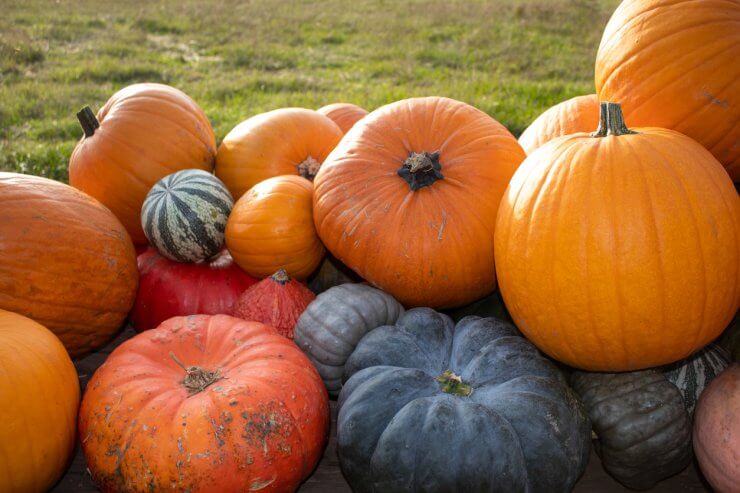You’ve grown pumpkins. You started them as seeds, watched them sprout, watched the vines spread and flower. And now you have pumpkins ready for harvest. Just one problem. You have a LOT of pumpkins and you’re probably wondering what to do with pumpkins so you can get the most enjoyment possible from them.
In case you haven’t harvested them yet, here’s a quick refresher.
Once your pumpkins have a hard rind and a mostly dry vine, they’re ready to harvest. Check each pumpkin, though, as they will probably all ripen at separate times.

To harvest them, just grab your pruning shears or a sharp knife and cut them carefully from the vine. Make sure to leave the stem, too, as that helps them keep a little longer. Pro tip: Be sure to wear gloves when you harvest your pumpkins; many varieties have sharp prickles on their stems.
Now then, what to do with pumpkins upon pumpkins upon pumpkins, because it only takes a few pumpkin vines to produce quite a few pumpkins!
Luckily, you have several options. Many of them leave you with pumpkin seeds. Naturally, that’s where our first idea begins.

10 Ideas for what to do with pumpkins now that the harvest is complete
1. Roasted Pumpkin Seeds. I love roasted pumpkin seeds. Instead of discarding or composting the seeds from jack-o-lanterns or pumpkin pie, you can save those seeds and make a mouth-watering snack packed with fiber, vitamins, and minerals. All you need is a little olive oil and some sea salt.
2. Make your own pumpkin purée. If you’re planning to make pumpkin pie or roasted pumpkin seeds, you might as well make a delicious pumpkin purée. This purée is easy to make and it’s also fantastic in pumpkin soup!
3. Make Pumpkin Pie. Give the traditional pumpkin pie a flavor boost with fresh pumpkin purée you can make yourself. You’ll wind up with a silky, flavorful pie that will have your guests coming back for seconds! If there’s any leftover, it freezes well. You don’t have to stick to just pie, either. Try one of these recipes for pumpkin crème brûlée, creamy pumpkin seed dressing, or flourless pumpkin muffins.
4. Throw your pumpkin! Pumpkin chucking is a popular activity, where competitors use catapults and other devices to throw pumpkins as far as possible. Some competitors even grow their own special varieties of pumpkins to improve their chances of winning.
5. Take your pumpkin to a festival. Do you have an especially unique pumpkin? The world’s largest pumpkin festival is held in Baden-Württemberg, Germany, where festival-goers can feast their eyes on 400,000 pumpkins!
6. Treat your skin. Want to look and feel better, inside and out? Well, eating pumpkin will give you a good dose of beta-carotene, which is not only good for your vision but for your skin, too. Beta-carotene helps protect your skin from the sun’s UV rays that cause wrinkles.
7. Decorate your home. Pumpkins can be orange, white, blue, and red. They can be the size of a softball or weigh thousands of pounds. They may be round, oval, smooth, or bumpy. And, of course, there’s the good old jack-o-lantern!
8. Can it! Did you know that you can preserve your pumpkins by canning them? Cut them into chunks and follow your favorite canning recipe.
9. Store it. You can store pumpkins (and other winter squash) for up to six months in the right conditions. I’ll share the details below.
10. Plant more pumpkins! Pumpkins are easy to grow. A friend has several in his front yard that grew randomly from decorative pumpkin seeds that ended up in the soil.
Saving your pumpkins for later
You’ve made pumpkin pie and pumpkin muffins. Your home is swimming in jack-o-lanterns and decorative pumpkins. You even made it to the quarter-finals in a pumpkin smashing contest. And you’re still wondering what to do with pumpkins after you harvest them because you have so darn many of them? Why not store them for later?
When you harvest pumpkins and other winter squash, leave about three inches of vine attached. This aids in preventing decay and helps your pumpkin last longer in storage. Let the pumpkins dry out in a warm location with good airflow for about 10 days. Ideal temperatures for curing are in the low 80s. If possible, space the pumpkins out on some kind of mesh or chicken wire to make sure air gets to all sides. If you can’t cure your pumpkins outdoors, a warm shed with good air circulation will work.
Once your pumpkins and winter squash have cured, find a shelf in a cool dark basement or at least the darkest corner of your pantry. Line whatever container or shelf you’re using with a newspaper or paper towel. Add a layer of straw if you have it. Nestle the pumpkins on the straw. Both newspaper and straw will help absorb moisture and prevent rot. Stacking pumpkins and squash can cause rot and decomposition, so keep them to one layer. Pumpkins and other winter squashes typically last between two to six months depending on the variety.
If you liked this article on pumpkins, we have a whole gardening guide on pumpkins that you will love. With our Pumpkin Gardening Guide, you’ll have everything you need to know about growing and enjoying this famous gourd. From pumpkin’s origin and background to specific advice about soil requirements and sunlight … from watering techniques to tips about avoiding diseases … from easy-to-make and delicious recipes that will allow you to enjoy this flavorful vegetable to the nutritional and health benefits of pumpkins—get it all in our Pumpkin Gardening Guide right now!


 Previous
Previous

